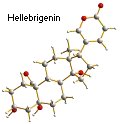
Members of the plant family Ranunculaceae are ever-popular at this time of year, especially in Europe, where the Christmas rose, Helleborus niger, is wheeled out as a natural decoration for countless households. Interesting then, that extracts of this plant have been used as a heart tonic in herbal medicine alongside the likes of digitalin (from foxglove) and strophanthin from the West African plant Strophanthus gratus.
H. niger contains various potent toxins in addition to cardiac glycosides helleborin, hellebrin and helleborein and saponosides and the ranunculoside derivative, protoanemonine. It was searching for information on the compound hellebrigenin (3-acetate) that brought one Sciencebase reader to this site, so here’s the structure of the molecule. This biologically active compound, which also goes by the name (3beta,5beta,14beta)-3,5,14-trihydroxy-19-oxobufa-20,22-dienolide, is a cardioactive steroid compound as well as having been demonstrated (in the 1960s) to have activity against tumour growth.
More on the Christmas Rose here.